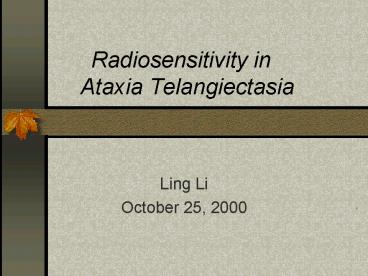Radiosensitivity in Ataxia Telangiectasia - PowerPoint PPT Presentation
1 / 19
Title:
Radiosensitivity in Ataxia Telangiectasia
Description:
After irradiation, normal cells held in a non-growing state have some recovery ... Irradiation at low dose-rates shows a very large sparing effect on normal cells, ... – PowerPoint PPT presentation
Number of Views:305
Avg rating:3.0/5.0
Title: Radiosensitivity in Ataxia Telangiectasia
1
Radiosensitivity in Ataxia Telangiectasia
- Ling Li
- October 25, 2000
2
Introduction
- Ataxia telangiectasia a human autosomal
recessive disorder - immune deficiency
- neurological abnormalities
- extreme radiosensitivity
- cell cycle anomalies
- predisposition to lymphoid and other
malignancies - incidence of AT is 1 in 40, 000 to 1 in 100, 000
3
The history of AT studies
- 1941 first description of AT
- 1957 characterized as a separated disease
- 1988 mapping of the AT gene to chromosome
11q22-23 - 1995 clone of AT mutated gene (ATM)
4
Basis of radiosensitivity (I) with sparsely
ionizing radiation
AT11LO
AT2LO
CRL1343
HF19 normal human strain
Three AT strains
5
Basis of radiosensitivity (I) with sparsely
ionizing radiation
- After irradiation, normal cells held in a
non-growing state have some recovery (or sparing)
from lethal effect, while AT cell lines show
little or no recovery - Irradiation at low dose-rates shows a very large
sparing effect on normal cells, while no or
little effect on AT cell
6
Basis of radiosensitivity (I) with densely
ionizing radiation
- Compared to sparsely ionizing radiation ( e.g.
x-ray), there is less difference in the damage
from densely ionizing radiation between AT cells
and normal cells
7
Basis of radiosensitivity (I)
summary
- All of these studies are consistent with an
inability of AT cells to recover from radiation
damage, and show that the defect cannot be
abrogated simply by allowing more time for damage
restitution.
8
Basis of radiosensitivity (II) chromosome
aberration
- Break repair a significantly elevated fraction
of unrepaired chromosomal breaks remain in AT
cells - after irradiation.
AT cell O GM-1525C
GM-0717A normal cells 3590P
Cell irradiated with 4 Gy
9
Basis of radiosensitivity (II)DNA breaks
- Mis-rejoining the frequency of mis-rejoining in
extracts from AT cell lines is about 20-fold
higher than in extracts from normal cell lines - Resistant DNA synthesis normal cells show a
rapid inhibition of DNA synthesis after
irradiation, while AT cells have a delay and/or
much reduced inhibition
10
Cell cycle control
cyclin A,B Cdc2
cyclin D Cdk2,4,6
M
G2
G1
cyclin A Cdk2
p21
S
cyclin ECdk2
p21p27
Rb phosphorylation
11
Cell cycle control and radiosensitivity
DNA Damage
induction of p53
induction of p21
PCNA-DNA polymerase d
Cyclin D,E/CDK2
Cyclin A, B /CDK2
Arrest in G1 if inhibited by p21
DNA replication inhibited
Arrest in G2/M
G1 phase cells
S phase cells
G2 phase cells
G1/S
G2/M
12
Cell cycle control and radiosensitivity
- Defect in G1/S checkpoint
- DNA damage in AT cell inadequate p53
response less increase in p21 activity
reduced inhibition of cyclin E-cdk2
cell progress from G1 to S phase is not
delayed - Defect in G2/M checkpoint
- the potential role of p53 in G2/M checkpoint (?)
- no increase in p21 associated with either
cyclinA-cdk2 or cyclinB-cdk2
13
Cell cycle control and radiosensitivity
Summary
- AT cells not arrested at either the G1/S or G2/M
checkpoint after exposure to radiation - The defect in cell cycle control in AT cell is
linked to p53.
14
The ATM gene
- The gene was cloned as a 5.9 kb partial cDNA and
was found to be mutated in 10 patients. - ORF (open reading frame) of the ATM gene is 9.168
kb and the size of the protein is 350 kDa
15
ATM protein
- The ATM gene encodes for a protein related to a
family of yeast and mammalian proteins containing
a phosphatidylinositol 3-kinase (PI3-kinase)
domain. - ATM proteins are found predominantly in the
nucleus.
16
ATM protein
- PI3-Kinase proteins
- Composed of a catalytic and a regulatory subunit
- Phosphorylating both lipid and protein substrates
- Some are involved in cell cycle checkpoint
control in response to DNA damage - Mec1p (S. cerevisiae)
- Rad3 (S. pombe)
- mei41 (D. melanogaster)
17
ATM protein
- ATM homologous protein
- DNA-dependent protein kinase (DNA-PK)
- DNA-PK
- a sensor of DNA damage
- phosphorylates DNA-bound substrates
- two components
- catalytic subunit (DNA-PK CS)
- DNA -binding component (Ku)
- cells deficient in DNA-PK are defective in
rejoining DNA breaks, hypersensitive to ionizing
radiation
18
Conclusion
- ATM is involved in the cell cycle control through
p53 - ATM may assist repairing DNA damage.
19
Future applications
- Gene therapy in cancer
- introduction of antisense constructs to reduce
ATM gene products - overexpression of cDNA fragments to compete for
interaction with other proteins































